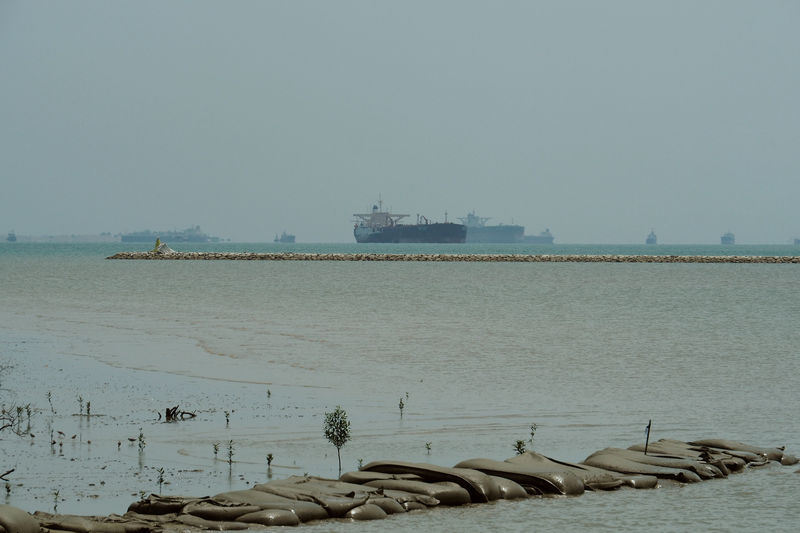* Hurricane Laura seen as biggest Gulf of Mexico threat
since
Katrina
* U.S., China reaffirm commitment to Phase 1 trade deal
* U.S. crude, gasoline stocks fall in last week -API
* Coming up: EIA inventory data at 1430 GMT
By Jessica Jaganathan
SINGAPORE, Aug 26 (Reuters) - The price of Brent crude oil
edged higher on Wednesday, lifted by U.S. producers shutting
most of their offshore output in the Gulf of Mexico ahead of
Hurricane Laura and optimism over China-U.S. trade talks.
But gains were capped amid renewed concern over the
coronavirus pandemic, which has squeezed fuel demand, after
reports from Europe and Asia of patients being re-infected with
COVID-19, raising concerns about future immunity.
Brent crude oil futures LCOc1 added 8 cents, or 0.2%, to
$45.94 a barrel by 0134 GMT, while U.S. West Texas Intermediate
crude CLc1 was down 2 cents, or 0.1%, at $43.33 a barrel. Both
benchmarks settled at a five-month high on Tuesday.
"Crude oil prices gained, dragged higher by surging gasoline
futures as Hurricane Laura heads towards the U.S. Gulf Coast,"
ANZ analysts said in a note on Wednesday.
The U.S. energy industry on Tuesday was preparing for a
major hurricane strike. Producers evacuated 310 offshore
facilities and shut 1.56 million barrels per day (bpd) of crude
output, 84% of Gulf of Mexico's offshore production - near the
90% outage that Hurricane Katrina brought 15 years ago.
"Markets are currently pricing in a possible near-term
catastrophic gasoline shortage," said Stephen Innes, chief
global markets strategist at AxiCorp.
Top U.S. and Chinese officials reaffirmed their commitment
to a Phase 1 trade deal, which has seen China lagging on its
obligations to buy American goods, potentially boosting flows
between the world's two largest oil consumers. Further price support came from data from the American
Petroleum Institute API/S showing U.S. crude oil stockpiles
fell more than expected last week. The U.S. Energy Information
Administration, the statistical arm of the Department of Energy,
will release its own official inventory data later on Wednesday.
Still, downward pressure came from concern about demand
after data showing U.S. consumer confidence has tumbled to its
lowest in more than six years due to concern about
coronavirus-induced job losses.
- English (USA)
- English (UK)
- English (India)
- English (Canada)
- English (Australia)
- English (South Africa)
- English (Nigeria)
- Deutsch
- Español (España)
- Español (México)
- Français
- Italiano
- Nederlands
- Português (Portugal)
- Polski
- Português (Brasil)
- Русский
- Türkçe
- العربية
- Ελληνικά
- Svenska
- Suomi
- עברית
- 日本語
- 한국어
- 简体中文
- 繁體中文
- Bahasa Indonesia
- Bahasa Melayu
- ไทย
- Tiếng Việt
- हिंदी
Brent rises on U.S. output cuts ahead of biggest storm threat in 15 years
Published 08/26/2020, 09:43 AM
Updated 08/26/2020, 09:50 AM
Brent rises on U.S. output cuts ahead of biggest storm threat in 15 years

Latest comments
Install Our App
Risk Disclosure: Trading in financial instruments and/or cryptocurrencies involves high risks including the risk of losing some, or all, of your investment amount, and may not be suitable for all investors. Prices of cryptocurrencies are extremely volatile and may be affected by external factors such as financial, regulatory or political events. Trading on margin increases the financial risks.
Before deciding to trade in financial instrument or cryptocurrencies you should be fully informed of the risks and costs associated with trading the financial markets, carefully consider your investment objectives, level of experience, and risk appetite, and seek professional advice where needed.
Fusion Media would like to remind you that the data contained in this website is not necessarily real-time nor accurate. The data and prices on the website are not necessarily provided by any market or exchange, but may be provided by market makers, and so prices may not be accurate and may differ from the actual price at any given market, meaning prices are indicative and not appropriate for trading purposes. Fusion Media and any provider of the data contained in this website will not accept liability for any loss or damage as a result of your trading, or your reliance on the information contained within this website.
It is prohibited to use, store, reproduce, display, modify, transmit or distribute the data contained in this website without the explicit prior written permission of Fusion Media and/or the data provider. All intellectual property rights are reserved by the providers and/or the exchange providing the data contained in this website.
Fusion Media may be compensated by the advertisers that appear on the website, based on your interaction with the advertisements or advertisers.
Before deciding to trade in financial instrument or cryptocurrencies you should be fully informed of the risks and costs associated with trading the financial markets, carefully consider your investment objectives, level of experience, and risk appetite, and seek professional advice where needed.
Fusion Media would like to remind you that the data contained in this website is not necessarily real-time nor accurate. The data and prices on the website are not necessarily provided by any market or exchange, but may be provided by market makers, and so prices may not be accurate and may differ from the actual price at any given market, meaning prices are indicative and not appropriate for trading purposes. Fusion Media and any provider of the data contained in this website will not accept liability for any loss or damage as a result of your trading, or your reliance on the information contained within this website.
It is prohibited to use, store, reproduce, display, modify, transmit or distribute the data contained in this website without the explicit prior written permission of Fusion Media and/or the data provider. All intellectual property rights are reserved by the providers and/or the exchange providing the data contained in this website.
Fusion Media may be compensated by the advertisers that appear on the website, based on your interaction with the advertisements or advertisers.
© 2007-2024 - Fusion Media Limited. All Rights Reserved.